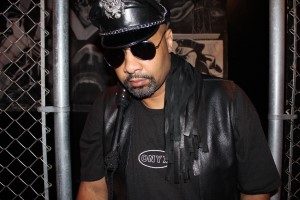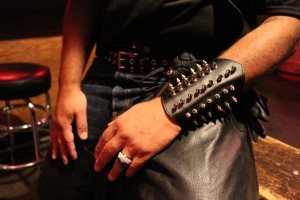Part of the Party
May 22, 2019 through October 20, 2019
Part of the Party: The Visual Story of the Onyx Brotherhood and Walter Houston III

In the summer of 2013 I began working on my Masters thesis for my Masters of Art Education degree at The School of the Art Institute of Chicago. I was excited to use my Master’s experience to interview and understand interactions between people. I am born with a natural ability to talk and understand people. I continually work to connect and refrain from immediate judgement. My goal is to be a participant and listener. I participate by asking in-depth and thoughtful questions. Part of the Party was a new venture for me as an artist, educator and ethnographer. Having visited the Leather Archives & Museum in early 2013, I was intrigued by the lives, rituals, and deeply connected communities in Bondage, Discipline, Submission & Masochism (BDSM). The visit was eye opening and incredible, but I noticed the museum lacked first person experiences, history and art about black communities in BDSM. Before I put out a call for interviewees, I researched the history of BDSM, well known BDSM historians, Cain Berlinger and Geoff Mains, and the Leather community Onyx Brotherhood.
I reached out to Onyx Brotherhood and was invited to their meet up at Touché Leather Bar. That night, I met with Onyx Brothers Mufasa, Cedric, Walter, and other Onyx members. Their community, the Onyx Brotherhood, was founded in 1995 and works to provide education, fraternization and serve as a bridge for Men of Color to the greater Leather community. The night brought conversation about their experience as queer people of color in a predominately white BDSM culture. Onyx Brother Walter Huston III continued to talk to me throughout the night and expressed interest in being interviewed. From that moment on, I dedicated my next 3 years to working with Walter to understanding his life as black gay identified male in Onyx Brotherhood and in the larger Leather and BDSM communities.

My interviews and meetings with Walter incorporated aspects of traditional one on one interviewing and reflexive ethnography. Reflexive Ethnography requires the researcher to be aware of his or her relationship to the field of study. I used this research method inform my questions, my presence as an outsider, and my art. Each painting, digital photographs, digitally edited photographs, and drawings shows a visual interpretation of Walter and the Onyx Brotherhoods experiences, interactions, and relationships. This work is my result.
I want to thank Walter Huston III, the Onyx Brotherhood, my professors at SAIC, and the Leather Archives Museum. This is the fruit of our joint labor of love.
About the artist, Erica Brooks: As an artist and arts educator I love to delve into the connections we all share as humans. I also love to dissect the differences between us that cannot be overlooked. I do this exploration through arts based storytelling. My process begins with interviewing individuals and then creating art as a way to reflect upon those interviews. These reflections are in the form of audio interviews, paintings, drawings, photography and digital art. When interviewing another person, my first goal is to avoid using my words to tell their story. The art is the bridge between my understanding of their story and their own words and experiences. My art translates into a visual representation of the feeling and aura of the individual I am interviewing. My art can help audiences visually connect with the interviewee and co-artist. As I grow as an artist, I hope use my work to tell stories that are not always heard in the mainstream media. I want to tell the stories of people of color, queer people, people of differing gender identities. By telling these stories creatively, I want open up the narrative of these groups beyond the stories heard in the media or throughout history. In the future, I will continue to tell stories and continue to make art.